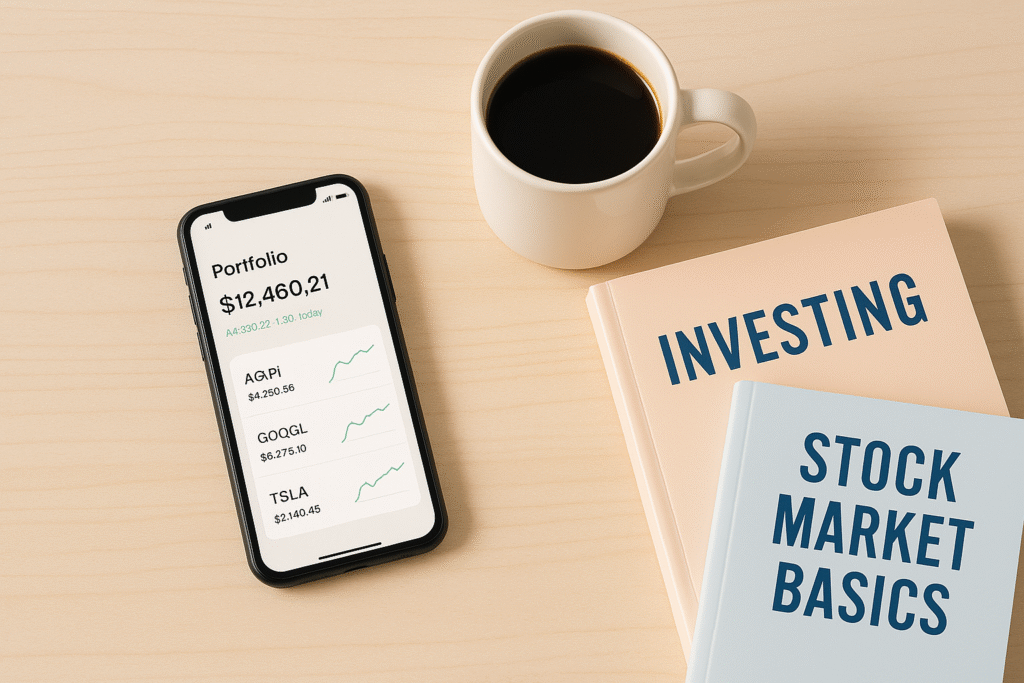Investing for beginners can feel like being dropped into a foreign country without a map or translator. The jargon is dense, the risks seem huge, and everyone online is either yelling about crypto or bragging about early retirement. It’s no wonder so many people never take the first step.
But here’s the truth: you don’t need thousands of dollars, a finance degree, or a perfect strategy to start. You just need a clear, simple path—and a little confidence to take that first leap.
This guide is your blueprint. We’ll walk you through everything from defining your goals to building your first portfolio with tools anyone can use. Whether you’ve never opened a brokerage account or you’re just tired of your savings sitting idle, you’re in the right place.
✨ Fun fact: nearly 42% of Americans aren’t investing at all—meaning you’re already ahead of the curve just by showing up. (📎 Gallup poll)
Let’s get you from zero to investor. No jargon. No fluff. Just smart, actionable steps.
Getting Started with Investing for Beginners

Know Your Why
Before you invest a single dollar, you need clarity on why you’re doing it. “To make money” isn’t enough—because when the market dips or your progress feels slow, that vague goal won’t motivate you to stay the course.
Are you investing to retire early? Buy a home in five years? Build financial freedom so you can say “no” to toxic jobs? Getting specific about your “why” makes it easier to pick the right strategy and stay committed. For example, if your goal is long-term wealth, index funds might be ideal. If you’re saving for a down payment in three years, a more conservative portfolio makes sense.
Write it down. Tape it to your laptop. Make it your phone background if you have to. Your “why” is your anchor in this process.
📎 Read more on goal-based investing from Vanguard
Don’t Skip the Basics
One of the biggest mistakes beginners make? Jumping straight into stock picking without understanding the basics. It’s like trying to bake a soufflé before you’ve boiled an egg.
Take time to learn the fundamentals: What’s a stock? What’s a bond? What’s diversification, and why does it matter? You don’t need to memorize every term—but understanding how these pieces fit together helps you invest smarter and avoid big missteps.
Here’s a better alternative: Start with a solid foundation. Read a few beginner articles. Watch a YouTube breakdown on index funds. Learn what risk tolerance really means.
📎 Check out our guide on Stock Market Basics
Mastering the basics isn’t boring—it’s empowering. And it’ll save you a lot of stress (and money) down the road.
Building Your First Portfolio as a Beginner

Pick the Right Platform
Choosing the right investing platform is like picking the right gym—it should match your needs, feel intuitive, and not charge you ridiculous fees just to show up.
For beginners, user-friendly apps like Fidelity, Charles Schwab, SoFi, or Robinhood can help you dip a toe into investing without feeling overwhelmed. If you want a more hands-off experience, robo-advisors like Betterment or Wealthfront build and manage a portfolio for you based on your goals and risk level.
Start with a platform that offers:
No minimum balance or low fees
Easy-to-understand dashboards
Educational resources or tutorials
📎 NerdWallet’s top beginner platforms
Remember: you’re not marrying your first app. You’re learning the ropes—comfort matters more than complexity.
Start with ETFs or Index Funds
Forget what TikTok told you—jumping into individual stocks isn’t the best starting line. What you really want are index funds or ETFs (exchange-traded funds). Why? They’re like financial smoothies: one share includes a mix of many different companies, which spreads your risk and keeps things simple.
Think of an S&P 500 ETF (like VOO or SPY) as a starter pack of the U.S. economy. Instead of betting on one company, you’re investing in hundreds. That’s powerful for beginners who want stability and steady growth.
Start small: $10, $20, $50. Set up recurring buys so it happens automatically.
📎 Here’s a breakdown on ETFs vs. mutual funds
Bonus: most brokerages now offer fractional shares, so you don’t need $300 to buy into a fund. You just need the will to begin.
Automate It
Want to know the single easiest way to become a consistent investor? Automation. Set a recurring transfer—weekly, bi-weekly, monthly—and forget about it.
Automation takes emotion out of the equation. No more stressing over timing or trying to “buy the dip.” You’re investing steadily, no matter what the market’s doing.
Even $10/week adds up. Over time, it becomes a habit—like brushing your teeth, but for your financial future.
📎 Set up auto-investing with M1 Finance
Small moves, done consistently, beat sporadic bursts of effort every time.
Smart Strategies for Investing for Beginners

Strategy or How-To – Dollar-Cost Averaging
Timing the market is a trap—even pros get it wrong. Enter dollar-cost averaging (DCA): a simple, effective strategy where you invest a fixed amount of money at regular intervals, regardless of the market’s ups and downs.
Let’s say you invest $100 every month. When prices are low, you buy more shares. When prices are high, you buy fewer. Over time, this averages out your cost per share and helps reduce the emotional whiplash of market volatility.
This method doesn’t require any market predictions—just consistency. Most brokerage platforms let you set up auto-investing so your money moves like clockwork.
📎 Morningstar explains dollar-cost averaging
It’s simple. It’s smart. And it’s especially perfect for beginners who want to build wealth without the drama.
Know What Affects Your Returns

Fees Eat Profits
Here’s an unsexy truth about investing that’ll save you thousands: fees matter—big time.
A 1% annual fee might not sound like much, but over 30 years, it could slash your returns by tens of thousands of dollars. That’s money that should be compounding quietly in your favor, not padding a manager’s paycheck.
Let’s say you invest $10,000 and earn an average of 7% annually. With no fees, that grows to about $76,000 in 30 years. Add a 1% fee? Now it’s closer to $57,000. You just lost nearly $19,000—without doing anything wrong.
So what should beginners look for?
Stick with low-cost index funds (like Vanguard or Schwab funds with 0.03% expense ratios).
Avoid high-fee mutual funds unless you truly understand their value.
Always check the expense ratio and platform fees before you invest.
📎 Use this free fee impact calculator from the SEC
Being fee-savvy isn’t nitpicking. It’s smart strategy—and it keeps more of your money growing for you.
Avoid These Rookie Investing Mistakes

Overreacting to Market Drops
Markets don’t just go up—they dip, dive, and sometimes downright crash. And for beginners, the first red day can feel like the sky is falling. Your instinct might scream: “Sell everything before I lose it all!”
Resist that urge.
Reacting emotionally to short-term losses is one of the most expensive mistakes you can make. Historically, markets recover—and long-term investors are the ones who benefit. Selling in a panic locks in your losses and throws your plan off course.
Instead, remember your long game. If your portfolio is diversified and built around your goals, temporary dips are just noise.
📎 How to Stay Calm in a Down Market
Going All-In Too Fast
Another rookie move? Dumping all your money into investments right away—especially on a hot tip or a gut feeling.
Investing is a marathon, not a sprint. Going all-in too fast can leave you vulnerable to bad timing, poor diversification, or emotional burnout. Instead, ease in gradually. Try dollar-cost averaging. Test different platforms. Build confidence before adding more fuel.
Also: Keep an emergency fund. You don’t want to pull out of your portfolio just because your car breaks down.
Start smart. Start steady. Let time—and compounding—do the heavy lifting.
Simple Habits That Help You Grow Wealth
![]()
Review Monthly, Adjust Yearly
Building wealth isn’t about obsessing over your portfolio every day—it’s about setting smart habits that keep you on track without stealing your sanity.
Here’s one of the best: review your investments monthly, adjust them yearly.
Each month, take 10 minutes to check:
Did your automatic transfers go through?
Any red flags with spending or bills?
Are you still on track with your goals?
That’s it. No panic-selling. No chasing trends. Just a quick check-in to stay mindful.
Then, once a year—maybe every January or on your birthday—rebalance your portfolio if it’s drifted too far from your target mix. For example, if stocks have grown and now make up 85% of your portfolio when your goal was 70%, consider selling a little and reinvesting into bonds or other assets.
This keeps your risk aligned with your goals—and keeps your wealth-building on autopilot.
📎 Try a free rebalancing tool like this from Schwab
Small, steady habits compound over time. They’re boring, yes—but boring is beautiful when it comes to money.
Track Your Net Worth Quarterly
If you only look at your investment account in isolation, you’re missing the bigger picture. Your net worth—what you own minus what you owe—is the real scoreboard.
Tracking it quarterly gives you a clear view of your progress, even if the markets are flat. Maybe your investments stayed steady, but your student loans dropped by $2,000. That’s a win. Or maybe you finally paid off a credit card and increased your cash cushion. Also a win.
Use a spreadsheet, an app like Empower, or even a simple notebook. Log:
Total investment accounts
Cash and savings
Debts (student loans, credit cards, etc.)
Net worth = Assets – Liabilities
Over time, these small snapshots become a powerful story of growth—and they’ll motivate you to stay the course.
📎 Check out this simple net worth calculator from NerdWallet
Knowing your numbers helps you make smarter money moves—and reminds you how far you’ve come.
Celebrate Milestones (Even the Small Ones)
Investing is a long game, but that doesn’t mean you have to wait 30 years to feel good about your progress. In fact, one of the smartest habits you can build is celebrating small financial wins along the way.
Did you invest your first $100? Celebrate. Hit your first $1,000 portfolio milestone? Absolutely celebrate. Set up auto-investing or stick to your plan for three months straight? That’s huge.
Positive reinforcement builds confidence—and confidence builds consistency.
Set mini-goals, track your progress, and reward yourself with something meaningful (not necessarily expensive). Maybe it’s a nice dinner, a hike with friends, or a new book on personal finance. The point is to recognize your growth.
📎 Here’s a list of investing milestones to track
Money is emotional. Celebrating small wins keeps you engaged, motivated, and proud of the future you’re building.
FAQ Section

Q: How much do I need to start investing?
A: You can start with as little as $1. Thanks to fractional shares and commission-free platforms like Fidelity and Robinhood, investing is more accessible than ever. Start small, stay consistent, and build as you go.
📎 Learn more about micro-investing with Acorns
Q: What’s the safest investment for beginners?
A: Broad-market index funds like those that track the S&P 500 are widely considered low-risk entry points for new investors. They offer instant diversification and have historically delivered steady returns over time.
📎 CFPB’s guide to safe investing
Q: How long does it take to see results?
A: Real investing is a slow burn. You might see gains in a few months, but meaningful growth happens over years. With regular contributions and smart choices, many beginners see positive results in 30–90 days, but the real power comes from compounding over decades.
📎 SEC’s compound interest explainer
Q: Do I need a financial advisor?
A: Not necessarily. Many beginners do just fine using robo-advisors or DIY platforms with built-in guidance. But if your finances are complex—or you just want peace of mind—a fee-only financial advisor can be worth it.
📎 Find a certified financial planner near you
Q: Can I lose all my money investing?
A: Only if you make reckless choices—like betting everything on one stock or following hype blindly. With a diversified portfolio and long-term mindset, risk is significantly reduced. Losses can happen, but total wipeouts are rare if you play it smart.
📎 Read: How to manage investment risk
Final Takeaway

Investing for beginners isn’t about being fearless—it’s about being curious enough to start and patient enough to stay the course.
You don’t need to time the market or pick the next Amazon. You just need a plan, a platform, and a little consistency. The magic of compound growth doesn’t require perfection—it just needs time, automation, and smart habits. Whether you’re putting in $10 or $100 a month, every dollar is a vote for your future.
So if you’ve been waiting for the “right time,” this is it. You’ve got the roadmap. You’ve got the tools. Now it’s about action.
Investing for beginners doesn’t have to be complicated—it just has to be yours. Build slowly, stay consistent, and trust that you’re doing something powerful: you’re building wealth on your terms.
📎 Optional tool: Try Vanguard’s investment goal planner
You’ve got this—and your future self will thank you for starting today. Keep your momentum going—read more on the Investillect blog.

